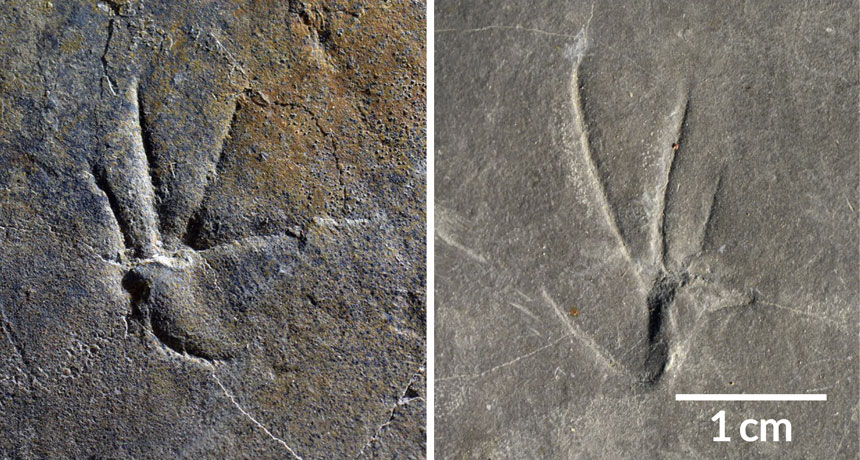Fossil footprints may put lizards on two feet 110 million years ago

Fossilized footprints from an iguana-like reptile provide what could be the earliest evidence of a lizard running on two legs.
The 29 exceptionally well-preserved lizard tracks, found in a slab of rock from an abandoned quarry in Hadong County, South Korea, include back feet with curved digits and front feet with a slightly longer third digit. The back footprints outnumber the front ones, and digit impressions are more pronounced than those of the balls of the feet. The lizard’s stride length also increases across the slab.
That’s what you’d expect to see in a transition from moseying along on four legs to scampering on two, says Yuong-Nam Lee, a paleontologist at Seoul National University who first came across the slab back in 2004. A closer examination two years ago revealed the telltale tracks.
Lee and his colleagues attribute the tracks to a previously unknown lizard ichnospecies, that is a species defined solely by trace evidence of its existence, rather than bones or tissue. Lee and his colleagues have dubbed the possible perpetrator Sauripes hadongensis and linked it to an order that includes today’s iguanas and chameleons in the Feb. 15 Scientific Reports.
Bipedal running certainly would have come in handy when escaping predatory pterosaurs some 110 million to 128 million years ago, the age of the rock slab. Lizard tracks are pretty rare in the fossil record, due to the reptiles’ lightweight bodies and penchant for habitats that don’t make great fossils. Though tracks appear in older fossils from the Triassic Epoch, 200 million to 250 million years ago, those prints belong to more primitive lizardlike reptiles. The new find edges out another set from the same region as the oldest true lizard tracks in the world by a few million years, the researchers say.
Plenty of modern lizards use two legs to scurry around. Some studies have linked similarities in ancient lizard bone structure to bipedal locomotion, but it is unclear exactly when lizards developed bipedalism. Lee’s team argues that these tracks represent the earliest and only direct evidence of bipedal running in an ancient lizard.
Martin Lockley, a paleontologist at the University of Colorado Denver who studies ancient animal tracks, points to alternative explanations. S. hadongensis might have trampled over front prints with its back feet, obscuring them and giving the appearance of two-legged running. Preservation can vary between back and front footprints. And the stride lengths aren’t quite as long as what Lockley says he’d expect to see in running. “Running or ‘leaping’ lizards make for a good story, but I am skeptical based on the evidence,” he adds.
So it may take the discovery of more fossilized lizard prints to determine whether S. hadongensis’ tracks truly represent running on two legs rather than simply scurrying on four.